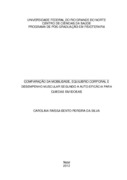Please use this identifier to cite or link to this item:
https://repositorio.ufrn.br/handle/123456789/16732| Title: | Comparação e mobilidade, equilíbrio corporal e desempenho muscular segundo a auto-eficácia para quedas em idosas |
| Other Titles: | Comparison of mobility, body balance and muscle performance according to self-efficacy for falls in the elderly |
| Authors: | Silva, Carolina Raissa Bento Pereira da |
| Advisor: | Maciel, álvaro Campos Cavalcanti |
| Keywords: | Envelhecimento. Mobilidade. Equilíbrio Corporal. Desempenho Muscular;Aging. Mobility. Body Balance. Performance Muscle |
| Issue Date: | 20-Dec-2012 |
| Publisher: | Universidade Federal do Rio Grande do Norte |
| Citation: | SILVA, Carolina Raissa Bento Pereira da. Comparison of mobility, body balance and muscle performance according to self-efficacy for falls in the elderly. 2012. 67 f. Dissertação (Mestrado em Movimento e Saúde) - Universidade Federal do Rio Grande do Norte, Natal, 2012. |
| Portuguese Abstract: | O processo de envelhecimento modifica diversos sistemas do organismo, levando a alterações de mobilidade, equilíbrio e força muscular. Isto pode ocasionar a queda no idoso, alterando ou não a auto-eficácia percebida em evitar quedas. Objetivo: Comparar a mobilidade, equilíbrio corporal e desempenho muscular segundo a auto-eficácia para quedas em idosas residentes na comunidade. Material e métodos: Estudo comparativo de corte transversal, com 63 idosas (65-80 anos) comunitárias. Foram avaliadas quanto aos dados de identificação e sóciodemográficos, rastreio cognitivo pelo Mini Exame do Estado Mental (MEEM), eficácia para quedas pela Escala de Eficácia de Quedas Internacional Brasil, (FES-I-BRASIL), mobilidade através do Timed Up and Go Test, equilíbrio pela Escala de Equilíbrio de Berg (EEB) e pelos testes Modified Clinical Test of Sensory Interaction on Balance (mCTSIB), Tandem walk (TW) e Sit to Stand (STS) do Balance Master System®. Por fim, o desempenho muscular por dinamometria isocinética. Na análise estatística foi realizado teste t de Student para comparação entre grupos, com p valor ≤ 0,05. Resultados: Comparando as idosas com baixa-eficácia para quedas com as com alta-eficácia para quedas, encontrou-se diferença significativa apenas para a variável Timed Up and Go Test (p=0,04). Quanto aos dados relativos aos testes de equilíbrio foram encontradas diferenças significativas na velocidade de oscilação superfície firme olhos abertos do teste modified Clinical Test of Sensory Interaction on Balance (p=0,01).Para as variáveis da dinamometria isocinética foram encontradas diferenças significativas no movimento de extensão do joelho, no que diz respeito as variáveis pico de torque (p=0,04) e potência (p=0,03). Conclusão: Os resultados sugerem que, comparando idosas de comunidade com baixa e alta-eficácia para quedas, observou-se diferenças nas variáveis relacionadas à mobilidade, equilíbrio e função muscular |
| Abstract: | The aging process modifies various systems in the body, leading to changes in mobility, balance and muscle strength. This can cause a drop in the elderly, or not changing the perceived self-efficacy in preventing falls. Objective: To compare the mobility, body balance and muscle performance according to self-efficacy for falls in community-dwelling elderly. Methods: A cross-sectional comparative study with 63 older (65-80 years) community. Were evaluated for identification data and sociodemographic, cognitive screening using the Mini Mental State Examination (MMSE), effective for the fall of Falls Efficacy Scale International Brazil (FES-I-BRAZIL), Mobility through the Timed Up and Go Test , the balance Berg Balance Scale (BBS) and the Modified Clinical Test tests of Sensory Interaction on Balance (mCTSIB), tandem walk (TW) and Sit to Stand (STS) of the Balance Master® System. Finally, muscle performance by using isokinetic dynamometry. Statistical analysis was performed Student t test for comparison between groups, with p value ≤ 0.05. Results: Comparing the elderly with low-efficacy for falls with high-efficacy for falls, we found significant differences only for the variable Timed Up and Go Test (p = 0.04). With regard to data on balance tests were significant differences in the speed of oscillation firm surface eyes open modified Clinical Test of Sensory Interaction on Test of Balance (p = 0.01). Variables to isokinetic dynamometry were no significant differences in movement knee extension, as regards the variables peak torque (p = 0.04) and power (p = 0.03). Conclusion: The results suggest that, compared to older community with low-and high-efficacy for falls, we observed differences in variables related to mobility, balance and muscle function |
| URI: | https://repositorio.ufrn.br/jspui/handle/123456789/16732 |
| Appears in Collections: | PPGFS - Mestrado em Fisioterapia |
Files in This Item:
| File | Description | Size | Format | |
|---|---|---|---|---|
| CarolinaRBPS_DISSERT.pdf | 1.69 MB | Adobe PDF |  View/Open |
Items in DSpace are protected by copyright, with all rights reserved, unless otherwise indicated.

